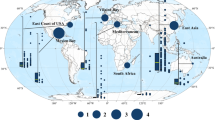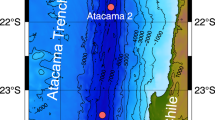Abstract
Toxic phytoplankton blooms threaten coastlines worldwide by diminishing beach quality and adversely affecting marine ecosystems and human health1,2. The common diatom genus Pseudo-nitzschia consists of several species known to produce the neurotoxin domoic acid3. Recent studies suggest that algal blooms dominated by Pseudo-nitzschia are increasing in frequency and duration owing to changes in coastal nutrient regimes1,4,5. However, few studies have examined the persistence or long-term biogeochemical cycling of domoic acid in marine waters6,7,8. Here, we measure the concentration of domoic acid in surface waters and sediment traps—up to 800 m in depth—off the coast of Southern California. We show that peaks in Pseudo-nitzschia abundance and domoic acid concentrations in surface waters coincide with peaks in diatom and toxin abundance at depth, suggesting rapid downward transport of the toxin. In some cases, the sinking particles contain over five times the United States federal limit of domoic acid. Detection of domoic acid in bottom sediments indicates that the toxin may persist long after the Pseudo-nitzschia blooms. Our results indicate that vertical fluxes of domoic acid are a substantial source of the toxin to deep-ocean food webs, and could explain high levels of domoic acid previously observed in benthic organisms9,10.
This is a preview of subscription content, access via your institution
Access options
Subscribe to this journal
Receive 12 print issues and online access
$259.00 per year
only $21.58 per issue
Buy this article
- Purchase on Springer Link
- Instant access to full article PDF
Prices may be subject to local taxes which are calculated during checkout




Similar content being viewed by others
References
Anderson, D. M., Glibert, P. M. & Burkholder, J. M. Harmful algal blooms and eutrophication: Nutrient sources, composition, and consequences. Estuaries 25, 704–726 (2002).
Hoagland, P., Anderson, D. M., Kaoru, Y. & White, A. W. The economic effects of harmful algal blooms in the United States: Estimates, assessment issues, and information needs. Estuaries 25, 819–837 (2002).
Trainer, V. L., Hickey, B. & Bates, S. S. in Oceans and Human Health: Risks and Remedies from the Sea (eds Smith, S. L., Walsh, P. J., Fleming, L. E., Solo-Gabriele, H. & Gerwick, W. H.) 219–237 (Elsevier Science, 2008).
Dortch, Q. et al. Abundance and vertical flux of Pseudo-nitzschia in the northern Gulf of Mexico. Mar. Ecol. 146, 249–264 (1997).
Parsons, M. L., Dortch, Q. & Turner, R. E. Sedimentological evidence of an increase in Pseudo-nitzschia (Bacillariophyceae) abundance in response to coastal eutrophication. Limnol. Oceanogr. 47, 551–558 (2002).
Fisher, J. M. et al. Role of Fe(III), phosphate, dissolved organic matter, and nitrate during the photodegradation of domoic acid in the marine environment. Environ. Sci. Technol. 40, 2200–2205 (2006).
Bouillon, R. C. et al. Photodegradation of the algal toxin domoic acid in natural water matrices. Limnol. Oceanogr. 51, 321–330 (2006).
Bouillon, R. C., Kieber, R. J., Skrabal, S. A. & Wright, J. L. C. Photochemistry and identification of photodegradation products of the marine toxin domoic acid. Mar. Chem. 110, 18–27 (2008).
Lefebvre, K. A., Bargu, S., Kieckhefer, T. & Silver, M. W. From sanddabs to blue whales: The pervasiveness of domoic acid. Toxicon 40, 971–977 (2002).
Vigilant, V. L. & Silver, M. W. Domoic acid in benthic flatfish on the continental shelf of Monterey Bay, California, USA. Mar. Biol. 151, 2053–2062 (2007).
Fritz, L. et al. An outbreak of domoic acid poisoning attributed to the pennate diatom Pseudonitzschia australis. J. Phycol. 28, 439–442 (1992).
Scholin, C. A. et al. Mortality of sea lions along the central California coast linked to a toxic diatom bloom. Nature 403, 80–84 (2000).
Silvagni, P. A. et al. Pathology of domoic acid toxicity in California sea lions (Zalophus californianus). Vet. Pathol. 42, 184–191 (2005).
Perl, T. M. et al. An outbreak of toxic encephalopathy caused by eating mussels contaminated with domoic acid. New Engl. J. Med. 322, 1775–1780 (1990).
Schnetzer, A. et al. Blooms of Pseudo-nitzschia and domoic acid in the San Pedro Channel and Los Angeles harbor areas of the Southern California Bight, 2003–2004. Harmful Algae 6, 372–387 (2007).
Buck, K. R. et al. Autecology of the diatom Pseudo-nitzschia australis, a domoic acid producer, from Monterey Bay, California. Mar. Ecol. 84, 293–302 (1992).
Maldonado, M. T., Hughes, M. P., Rue, E. L. & Wells, M. L. The effect of Fe and Cu on growth and domoic acid production by Pseudo-nitzschia multiseries and Pseudo-nitzschia australis. Limnol. Oceanogr. 47, 515–526 (2002).
Kvitek, R. G., Goldberg, J. D., Smith, G. J., Doucette, G. J. & Silver, M. W. Domoic acid contamination within eight representative species from the benthic food web of Monterey Bay, California. Mar. Ecol. 367, 35–47 (2008).
Vale, P. & Sampayo, M. A. Domoic acid in Portuguese shellfish and fish. Toxicon 39, 893–904 (2001).
Costa, P. R., Rodrigues, S. M., Botelho, M. J. & Sampayo, M. A. A potential vector of domoic acid: The swimming crab Polybius henslowii Leach (Decapoda-brachyura). Toxicon 42, 135–141 (2003).
Burns, J. M. & Ferry, J. L. Adsorption of domoic acid to marine sediments and clays. J. Environ. Monitoring 9, 1373–1377 (2007).
Anderson, C. R., Siegel, D. A., Kudela, R. M. & Brzezinski, M. A. Empirical models of toxigenic Pseudo-nitzschia blooms: Potential use as a remote detection tool in the Santa Barbara Channel. Harmful Algae 8, 478–492 (2009).
Alldredge, A. L. & Gotschalk, C. C. Direct observation of the mass flocculation of diatom blooms: Characteristics, settling velocities and formation of diatom aggregates. Deep Sea-Res. I 36, 159–171 (1989).
Thunell, R. et al. Particulate organic carbon fluxes along upwelling-dominated continental margins: Rates and mechanisms. Glob. Biogeochem. Cycles 21, GB1002 (2007).
Lail, E. M. et al. The role of particles on the biogeochemical cycling of domoic acid and its isomers in natural water matrices. Harmful Algae 6, 651–657 (2007).
Hampson, D. R. et al. Interaction of domoic acid and several derivatives with kainic acid and ampa binding-sites in rat-brain. Eur. J. Pharmacol. 218, 1–8 (1992).
Anderson, C. R., Brzezinski, M. A., Washburn, L. & Kudela, R. Circulation and environmental conditions during a toxigenic Pseudo-nitzschia australis bloom in the Santa Barbara Channel, California. Mar. Ecol. 327, 119–133 (2006).
Rines, J. E. B. et al. Thin layers and camouflage: Hidden Pseudo-nitzschia spp. (Bacillariophyceae) populations in a fjord in the San Juan Islands, Washington, USA. Mar. Ecol. 225, 123–137 (2002).
Hasle, G. R. in Phytoplankton Manual (ed. Sournia, A.) 88–96 (UNESCO, 1978).
Acknowledgements
We thank A. Michaels and D. Capone for the use of the SPB sediment traps; D. Hammond for help in processing SPB sediment-trap samples; E. Tappa for his help in deployments and recoveries of the SBB trap; N. Guillocheau and the Channel Islands National Marine Sanctuary for help with SBB water collections; R. Kudela for providing laboratory facilities for Pseudo-nitzschia and DA analyses of surface SBB water samples and J. Gully, C. Tang and the Los Angeles County Sanitation Districts for providing sediment core samples. This work was supported by NSF OCE 0351169 and OCE 0850425, EPA RD-83170501, NOAA NA160P2790, NOAA Sea Grant NA06OAR4170012 and NASA NNX08AG82G.
Author information
Authors and Affiliations
Contributions
E.S.-W., A.S. and C.R.B.-N. measured DA concentrations, conducted Pseudo-nitzschia cell counts and handled data interpretation for the SBB and SPB datasets. J.M.B. and J.L.F. helped in the development of the LC-MS/MS method for SBB. S.L.M. provided SEM images. C.A. provided surface DA and Pseudo-nitzschia cell concentrations for SBB. E.F. measured DA with ELISA kits on SPB samples. R.S. and I.C. assisted sampling collection throughout the covered time period in the SPB area. R.T. and W.M.B. provided sediment-trap samples in SBB and SPB, respectively. D.A.C., B.H.J., P.E.M. and D.A.S. provided support and infrastructure for the SPB Pseudo-nitzschia and DA measurements.
Corresponding author
Rights and permissions
About this article
Cite this article
Sekula-Wood, E., Schnetzer, A., Benitez-Nelson, C. et al. Rapid downward transport of the neurotoxin domoic acid in coastal waters. Nature Geosci 2, 272–275 (2009). https://doi.org/10.1038/ngeo472
Received:
Accepted:
Published:
Issue Date:
DOI: https://doi.org/10.1038/ngeo472
This article is cited by
-
Marine toxin domoic acid alters nitrogen cycling in sediments
Nature Communications (2023)
-
A new pathway for anaerobic biotransformation of marine toxin domoic acid
Environmental Science and Pollution Research (2023)
-
Influence of the Mississippi River on Pseudo-nitzschia spp. Abundance and Toxicity in Louisiana Coastal Waters
Estuaries and Coasts (2016)
-
Development and environmental application of a genus-specific quantitative PCR approach for Pseudo-nitzschia species
Marine Biology (2010)



